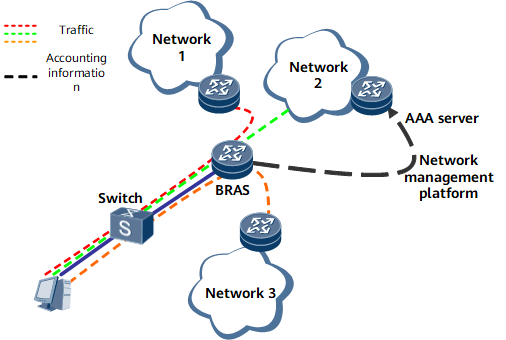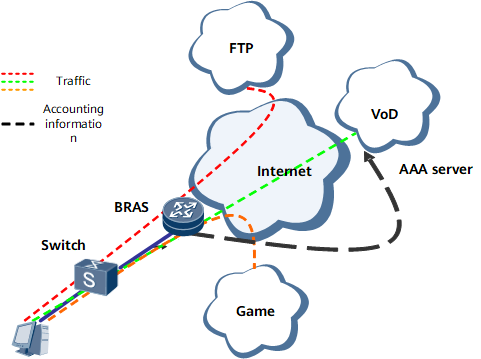Typical EDSG Networking
Separate Operation for Local and Toll Networks
In a region where a toll network and a local network are separately deployed, the local carrier must rent the toll network carrier's expensive egress link for connecting to the Internet and pay the toll network carrier for expensive Internet traffic. Internet traffic and intranet traffic have large cost differences. Therefore, the local carrier needs to distinguish between Internet traffic and intranet traffic and perform accounting based on different tariff levels to ensure revenues.
When a user visits networks 1 to 3 shown in Figure 1, accounting based on volume and time is performed for traffic over the three networks. Three EDSG services are planned for the three networks, and accounting is independently performed for each service.
Accounting Based on Used Services
Different bandwidths are provided for different network services, and accounting is independently performed for all of the network services. A policy server can be used to dynamically change the number and bandwidth of network services. Volume and duration quotas can also be delivered for the services. After a user's quotas are exhausted, HTTP requests matching the user's service flow are redirected to a recharge page.
When a user visits the game, FTP, and VoD networks shown in Figure 2, rate limit is performed on traffic over the three networks. Three EDSG services are planned for the three networks, and rate limit and accounting are independently performed for each service.
Different Bandwidths for Networks Inside and Outside a Campus
Networks inside and outside a campus can be distinguished based on the network segment addresses accessed by campus users, and different bandwidths are used for traffic over the networks. When a campus user goes online, a BRAS sends an authentication request packet to a RADIUS server. After receiving the packet, the RADIUS server delivers two EDSG service policies for traffic over networks inside and outside a campus to limit the bandwidth of traffic over the networks. In addition, the RADIUS server performs accounting only for traffic over the network outside a campus.

